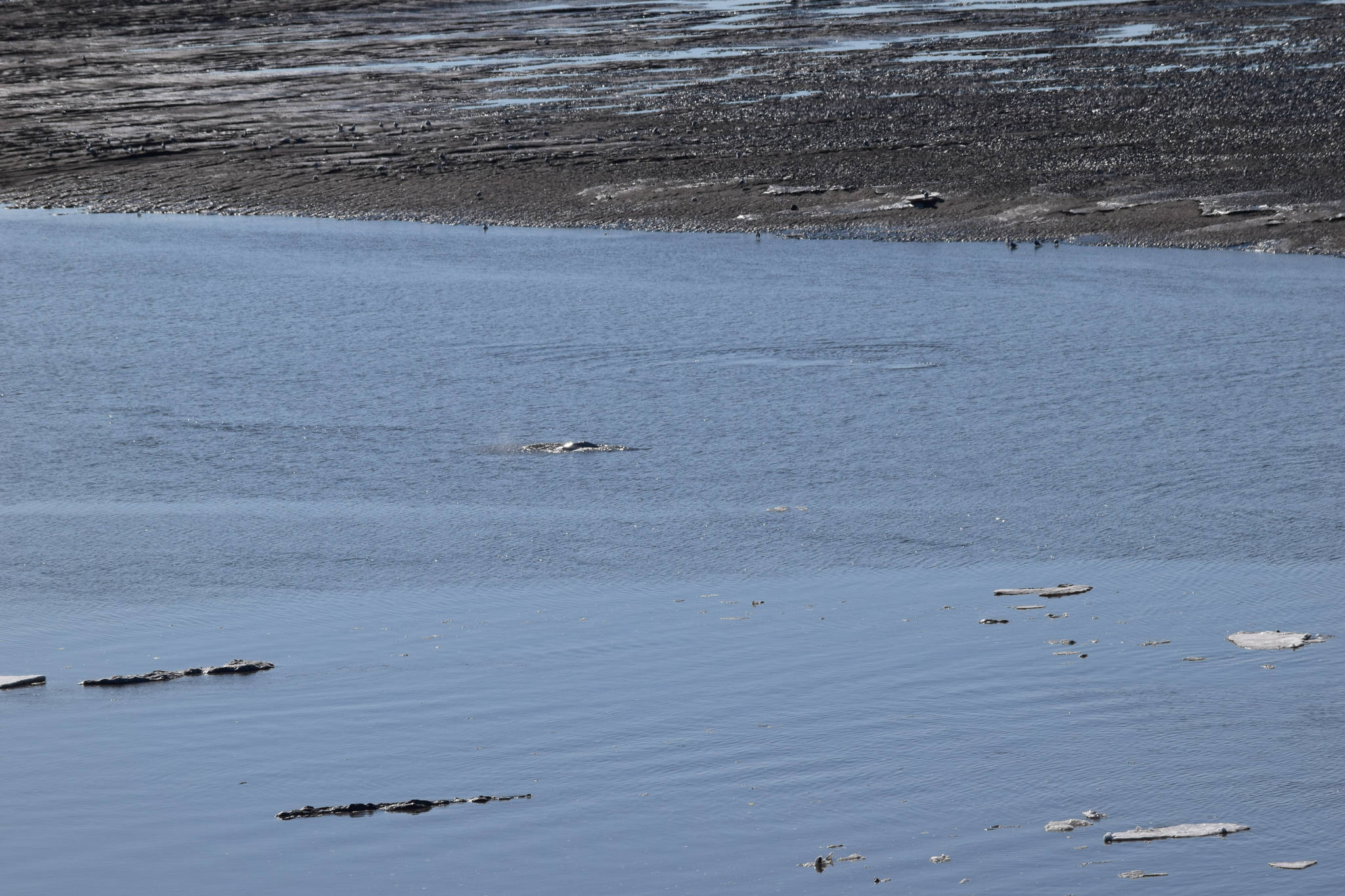The mouth of the Kenai River was quiet on Saturday morning as Teresa Becher mounted her camera on a standing tripod.
Becher, a volunteer citizen scientist coordinator with the Alaska Beluga Monitoring Partnership, has been counting whales from the Kenai Bluffs almost every day for over a month.
She’s retired but is going back to school to study natural sciences. For one of her classes, Becher had the opportunity to intern with the Alaska Wildlife Alliance and became the beluga monitoring coordinator for the Cook Inlet area.
Belugas are pretty unique. These mammals are known as the canaries of the sea because of their use of echolocation and sonar to navigate waters, and can hold their breath for up to 15 or 20 minutes.
Additionally, their “melon” heads make them the only whales capable of bending their necks, moving their heads back and forth, and making facial expressions. Belugas are social animals as well; they travel in pods, and some researchers even believe they give names to their young.
As the 19-foot tide went out on Saturday morning, Becher and the rest of the monitoring team saw an estimated six belugas break the surface of the water.
They swam upriver all the way to Cunningham Park, and then back down to the inlet again. One particularly playful whale even flipped its mermaid-looking tail, or fluke, out of the water as it swam under Warren Ames Memorial Bridge.
Among the monitoring team was Suzanne Steinert, founder and president of the nonprofit Beluga Whale Alliance; Madison Kosma, the National Oceanic and Atmospheric Administration coordinator for Alaska Beluga Monitoring Partnership; Deborah Boege Tobin, professor of biological sciences at Kenai Peninsula College and coordinator of the Semester by the Bay program; Mia Werger, one of Tobin’s students; and Kelly Matthews, a volunteer citizen scientist.
Steinert said one of the alliance’s primary goals is to connect the public to belugas.
“The more people get out seeing the whales and connecting with them and appreciating them, the more people will learn about them, value them and then help support recovery actions,” she said.
Steinert said she had always been inspired by wildlife, and once she saw her first beluga whale interning at the Alaska Wildlife Conservation Center, she was hooked.
“I learned they were endangered, and I was like, ‘I’m going to save them,’” she said. “I decided I really wanted to pursue endangered species conservation.”
According to NOAA, the Cook Inlet beluga population has decreased about 80% since 1979, from an estimated 1,300 whales to now just around 279.
There are many factors that have contributed to their population decline, including over-hunting, habitat degradation, pollution and human disturbance, according to NOAA. Saturday’s monitoring team said they are now critically endangered.
“For Alaska Native people, even though over-harvest initially, when it was unregulated, was the cause of their decline, they’ve lived with belugas in this region for thousands of years,” Steinert said. “They deserve to be able to have that relationship revitalized too, … and their voices should be heard to a greater degree.”
Steinert conducted research on the Cook Inlet beluga population for her master’s degree, mostly monitoring the whales along the Turnagain Arm.
“I learned … the importance of people being able to see and appreciate them and connect to them in that way,” Steinert said.
Kosma coordinates citizen scientist volunteers and different educational programs for NOAA, and said she has been interested in marine biology ever since she can remember.
“I started with my undergrad in Hawaii, and I did coral work, but I just couldn’t stop being interested in the charismatic megafauna of whales,” Kosma said.
Kosma later went to Sitka to research humpback, sperm and killer whales, and then moved to Anchorage to work with the beluga team once she finished her master’s degree.
She only started coordinating monitoring sessions in the fall of 2019, so this is the team’s first spring season. Last spring they were unable to count belugas together because of the pandemic.
Kosma said the biggest way people can help the beluga species is to report sightings through the Cook Inlet Photo ID Project.
“Just people, out adventuring around the rivers or in Cook Inlet, seeing whales and giving reports have been super helpful for NOAA and conservation efforts because there’s only so many of us,” she said.
Kosma also said she would encourage anyone interested in belugas to volunteer as a monitor.
“At the end of the day, they’re the heroes; they’re out here making it happen,” she said. “It’s incredible what the locals are willing to do to help beluga whales.”
The Alaska Wildlife Alliance and Kenai Peninsula College are the two major local affiliates of Alaska Beluga Monitoring Partnership and NOAA. The best time for beluga watching in the Kenai River is shortly after low tide as the tide starts coming back in.
Reach reporter Camille Botello at camille.botello@peninsulaclarion.com.


